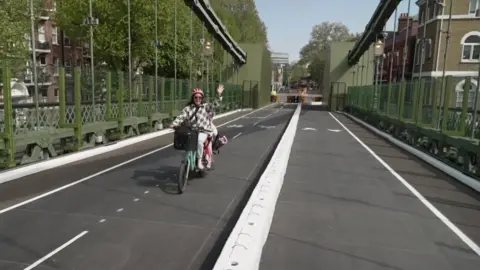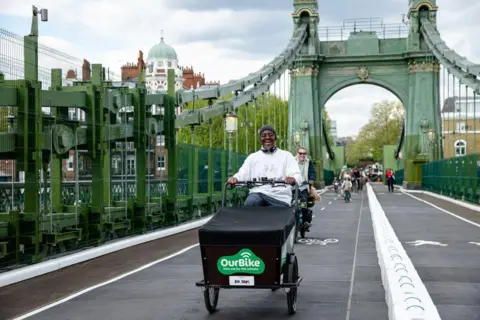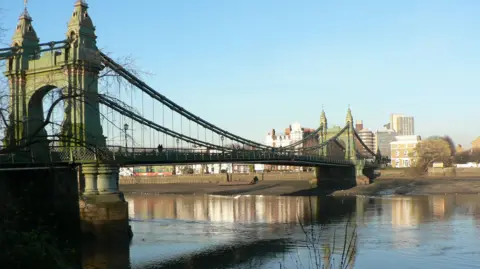Hammersmith Bridge opens for cyclists after refurb
 BBC
BBCHammersmith Bridge is now open to cyclists, but no decision has been taken on when it will be used again by cars.
The 138-year-old structure had been closed to motor vehicles since April 2019, when cracks appeared in its pedestals.
Over the Easter Bank Holiday weekend the main carriageway reopened with new decking after a £2.9m refurbishment, opening it up to cyclists.
The London Borough of Hammersmith and Fulham, which owns the Grade II*-listed bridge, said this would mean an improved experience for pedestrians, cyclists and e-scooter users.
 Hammersmith and Fulham Council
Hammersmith and Fulham CouncilThere are now three separate lanes in the carriageway: one for cyclists travelling north, another for cyclists going south and a third two-way pedestrian path.
The outer footways will also remain open to pedestrians only.
The council said the new, wider pedestrian lane offers more space, improving accessibility for people who use wheelchairs.
It added that e-cargo bikes, which fit between the newly installed 1.2m (4ft) wide anti-terror barges, are also being trialled on the bridge to shuttle older and disabled residents as well as young children.
Hammersmith Bridge links Hammersmith on the north side of the River Thames with Barnes in the south.
Last year the cost of repairing the river crossing nearly doubled from initial estimates to £250m.
The cost is to be split three ways between the council, the Department for Transport (DfT) and Transport for London (TfL).

The council previously said it proposed fully reopening the cast-iron structure and restoring it to its "original Victorian splendour".
Among the options being considered are a toll or a ban on cars.
A DfT suggestion to demolish it and replace it with a new crossing was rejected at a meeting in January of a taskforce that included council representatives, MPs from either side of the bridge, TfL and London's deputy mayor for transport, Seb Dance.
The council said it had spent £48m so far on restoring and keeping Hammersmith Bridge safe since August 2020, when it was fully closed on safety grounds.
The bridge had to be lifted off its original Victorian bearings using a hydraulic jacking system to allow engineers to replace the seized bearings with modern rubber ones, which ensured the bridge could respond safely to temperature changes and movement.
In addition, customised steel frameworks were installed to support the historic structure during the jacking operations. To make the frames, the steel was imported in 29 giant sheets and then cut into 1,220 bespoke pieces.
In 2021, the bridge was reopened to pedestrians and cyclists but later closed again. Last year the council opened a temporary cycle lane for 10 weeks during a pause in the works.
Listen to the best of BBC Radio London on Sounds and follow BBC London on Facebook, X and Instagram. Send your story ideas to [email protected]
